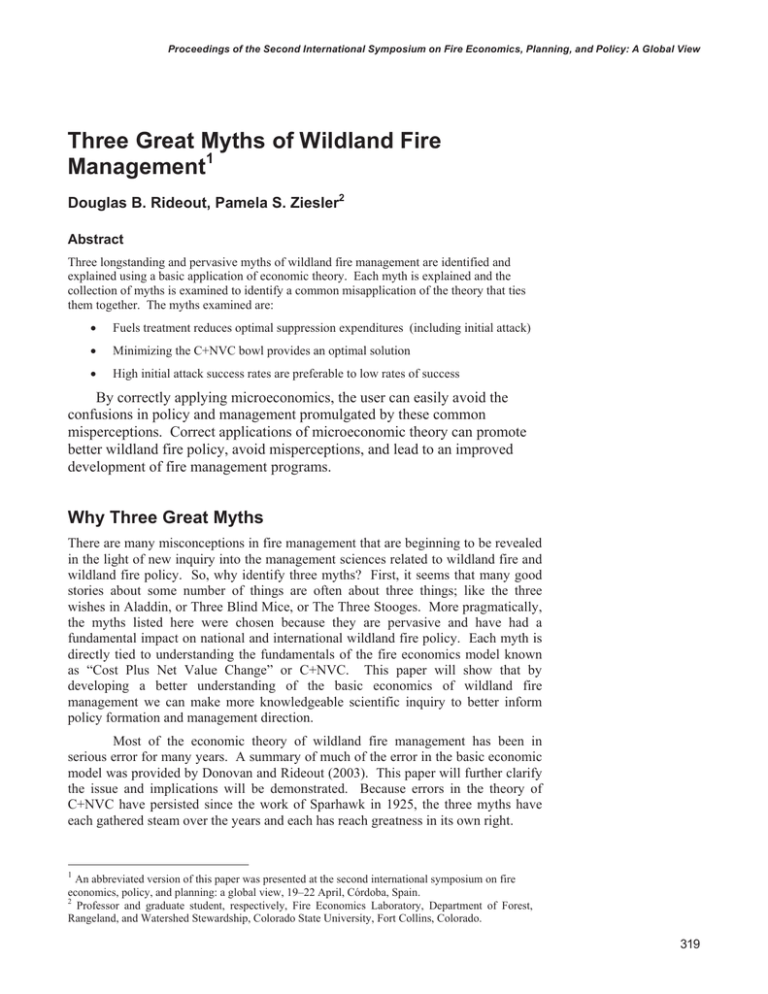Document 11233245
advertisement

Proceedings of the Second International Symposium on Fire Economics, Planning, and Policy: A Global View Three Great Myths of Wildland Fire Management1 Douglas B. Rideout, Pamela S. Ziesler2 Abstract Three longstanding and pervasive myths of wildland fire management are identified and explained using a basic application of economic theory. Each myth is explained and the collection of myths is examined to identify a common misapplication of the theory that ties them together. The myths examined are: x Fuels treatment reduces optimal suppression expenditures (including initial attack) x Minimizing the C+NVC bowl provides an optimal solution x High initial attack success rates are preferable to low rates of success By correctly applying microeconomics, the user can easily avoid the confusions in policy and management promulgated by these common misperceptions. Correct applications of microeconomic theory can promote better wildland fire policy, avoid misperceptions, and lead to an improved development of fire management programs. Why Three Great Myths There are many misconceptions in fire management that are beginning to be revealed in the light of new inquiry into the management sciences related to wildland fire and wildland fire policy. So, why identify three myths? First, it seems that many good stories about some number of things are often about three things; like the three wishes in Aladdin, or Three Blind Mice, or The Three Stooges. More pragmatically, the myths listed here were chosen because they are pervasive and have had a fundamental impact on national and international wildland fire policy. Each myth is directly tied to understanding the fundamentals of the fire economics model known as “Cost Plus Net Value Change” or C+NVC. This paper will show that by developing a better understanding of the basic economics of wildland fire management we can make more knowledgeable scientific inquiry to better inform policy formation and management direction. Most of the economic theory of wildland fire management has been in serious error for many years. A summary of much of the error in the basic economic model was provided by Donovan and Rideout (2003). This paper will further clarify the issue and implications will be demonstrated. Because errors in the theory of C+NVC have persisted since the work of Sparhawk in 1925, the three myths have each gathered steam over the years and each has reach greatness in its own right. 1 An abbreviated version of this paper was presented at the second international symposium on fire economics, policy, and planning: a global view, 19–22 April, Córdoba, Spain. 2 Professor and graduate student, respectively, Fire Economics Laboratory, Department of Forest, Rangeland, and Watershed Stewardship, Colorado State University, Fort Collins, Colorado. 319 USDA Forest Service Gen. Tech. Rep. PSW-GTR-xxx. xxxx. GENERAL TECHNICAL REPORT PSW-GTR-208 Session 3B—Three Great Myths of Wildland Fire—Rideout, Ziesler Myth One: Fuels Treatment Reduces Optimal Suppression Expenditures and Optimal Wildland Fire Damage This myth, while widely assumed to be true in each of its two parts, will be shown to have no basis in the economic theory as represented by the C+NVC model. Understanding this myth requires an understanding of the impact that fuels treatment may have on the NVC function. The NVC function shows how net damage from a wildland fire is affected by a particular decision variable. In our development, NVC is reduced by increasing dosages of fire fighting effort. Each part of this myth is developed below. Fuels Treatment May Increase Optimal Fire Fighting Contrary to the myth, fuels treatment may increase optimal fire fighting effort and expenditure. This is best explained by examining Figure 1. Figure one shows total cost on the vertical axis and total fire fighting effort on the horizontal axis. Net value change is shown as a declining function of fire fighting effort and the cost of fire fighting effort is shown as a linear increase (for ease of illustration) over fire fighting effort. These two cost functions are vertically summed to form the “C+NVC” bowl shape shown in the illustration. The usual objective function is to select the firefighting effort that will produce the minimum point on the bowl. As shown in Rideout and Omi (1990) and other works, the minimum point will occur when the slopes of the two underplaying cost functions are equal in absolute value. Important to understanding the nature of the myths is that only the slopes, not the locations, of the cost functions matter in locating the minimum point on the bowl. To understand how fuel treatment may increase optimal fire fighting, consider how fuel treatment can affect the NVC function. In figure one, the “before (dashed) and after” (solid) picture is taken of the NVC functions. In this example, the NVC function lowers and steepens throughout. It lowers because we would expect lower damage at higher levels of fire fighting effort and it steepens because we expect firefighting effort to increase in marginal productivity. In fact, these are both frequent reasons given for hazardous fuels treatments. If the NVC curve steepens enough, the minimum of the C+NVC bowl will migrate to the right of the original bowl as shown in Figure 1. In this example, optimal damage has greatly decreased as a result of the lower NVC function (NVC before treatment is higher than NVC’ after treatment) but fire fighting effort and corresponding expenditure have increased. 320 USDA Forest Service Gen. Tech. Rep. PSW-GTR-xxx. xxxx. Proceedings of the Second International Symposium on Fire Economics, Planning, and Policy: A Global View Session 3B—Three Great Myths of Wildland Fire—Rideout, Ziesler 18 16 14 Cost ($) 12 FF Cost NVC C+NVC NVC' C+NVC' 10 8 6 4 2 0 0 0.2 0.4 0.6 0.8 1 1.2 Fire Fighting Effort Figure 1—Fuels Treatment May Increase Optimal Fire Fighting Effort. It is important to note that this is only one possible outcome. However, to be consistent with economic theory one must consider the possibility that fuels treatment may well cause an increase in optimal fire fighting effort. The point is that fuels treatment may increase or decrease optimal firefighting effort and expenditure, but this outcome is not predictable by the theory alone. Fuels Treatment May Increase Optimal Damage A direct parallel to the result in Figure 1 is a different kind of shift in the NVC curve as a result of fuels treatment. Suppose that the fuels treatment operated on the NVC function by lowering it while also decreasing its slope. It becomes flatter throughout as in Figure 2. Here our fuels treatment has done something to the vegetation or to the site condition that reduces the marginal productivity of fire fighting. If the reduction in slope is large enough relative to the other functions, the counterintuitive result can be achieved that optimal damage may increase as shown in Figure 2. 18 16 14 Cost ($) 12 FF Cost NVC C+NVC NVC' C+NVC' 10 8 6 4 2 0 0 0.2 0.4 0.6 0.8 1 1.2 Fire Fighting Effort Figure 2—Fuels Treatment Increases Optimal Damage. 321 USDA Forest Service Gen. Tech. Rep. PSW-GTR-xxx. xxxx. GENERAL TECHNICAL REPORT PSW-GTR-208 Session 3B—Three Great Myths of Wildland Fire—Rideout, Ziesler Here, with fuels treatment, the NVC function has shifted from NVC to NVC’ and C+NVC has shifted to C+NVC’. Because the marginal productivity of fire fighting has diminished, a lower dose of fire fighting is purchased. While the lower NVC function acts to reduce damage, this is off-set by the decline in optimal fire fighting effort such that optimal damage increases from 10 to 12 in the figure. Optimal damage may increase or decrease and this cannot be resolved without further information. Myth Two: Minimizing the C+NVC Initial Attack Bowl Provides an Optimal Solution for the Fire Program. Since the early days of Sparhawk and the development of the “Contemporary Sparhawk” (nearly 30 years ago) as shown in Figure 3, there has been recognition that the firefighting problem is composed of at least two parts: initial attack and extended attack. In some instances, the problem can be subdivided into even more parts, but we will consider just two for this development. Total Cost ($) C+NVC Preparedness Suppression NVC “MEL” Total Fire Fighting Effort Figure 3—Contemporary Sparhawk Error (Donovan and Rideout 2003). Figure three is an attempt to include the cost of extended attack in the C+NVC framework through a function confusingly labeled “suppression.” The horizontal axis is often labeled “program level” or “preparedness”, but for simplicity and consistency let’s consider it to be fire fighting effort in the initial attack phase. Functions are defined as in the previous section except for the inclusion of the suppression function that is shown to decline with increasing initial attack. The rationale is characterized as this: the greater the effort in initial attack, the lower the optimal effort should be in extended attack or suppression. The key error in the 322 USDA Forest Service Gen. Tech. Rep. PSW-GTR-xxx. xxxx. Proceedings of the Second International Symposium on Fire Economics, Planning, and Policy: A Global View Session 3B—Three Great Myths of Wildland Fire—Rideout, Ziesler diagram that is discussed here for the first time is the “mixing of accounts” between initial and extended attack. While the cost effect of initial attack on extended attack is accounted for, the NVC portion of extended attack is not. In effect, the diagram brings over the cost function from extended attack and blends it with initial attack in an incorrect manner while omitting any effect of extended attack on NVC. We now have an account (initial attack) and a half (extended attack) so that the bowl itself is economically meaningless. Nevertheless, it incorrectly suggests that increases in program funding will lead to reductions in suppression costs. While this might occur, it would not be based on Figure 3. One approach would be to remove the suppression function and minimize the bowl for initial attack. This correction is at the root of the second myth: that the minimum of the initial attack bowl produces an optimal initial attack solution. This solution is provided in the “Initial Attack” panel of Figure 4. Initial Attack Extended Attack Cost ($) Cost ($) MIN + IAo EAo Fire Fighting Effort Fire Fighting Effort Total Cost ($) = IAo + EAo ? To Total Fire Fighting Effort Figure 4.—Optimal Program Illustration. 323 USDA Forest Service Gen. Tech. Rep. PSW-GTR-xxx. xxxx. GENERAL TECHNICAL REPORT PSW-GTR-208 Session 3B—Three Great Myths of Wildland Fire—Rideout, Ziesler The minimum of the C+NVC bowl in the Initial Attack panel provides an incorrect answer to the optimal fire fighting problem because fires that are not successfully contained in initial attack represent a cost that must be addressed elsewhere—usually in the extended attack phase. Therefore, the minimum of the initial attack bowl (unadjusted) contains an externality that is not accounted for without a more holistic approach. Like a factory spewing effluent into a river, the unadjusted initial attack framework spews the cost of large fires into extended attack. The general problem and corrections for this are well known in economics. Here we correct for this problem by minimizing the sum of the initial and extended attack C+NVCs as shown in the panel “Total Fire Fighting Effort.” We can also correct the Initial Attack panel to adjust for the externality (not shown). Three conclusions are apparent: (1) the minimum of the initial attack bowl represents an incorrect solution that can be fixed and (2) the “fix” included in the contemporary Sparhawk is erroneous and (3) a correct solution is to minimize the sum of the C+NVCs. Myth Three: High Initial Attack Success Rates are Preferable. While high initial attack success rates are preferable sometimes, this is not always the case. This myth is often at the heart of defining useful performance measures. In Figure 4 we can see that there is an optimal amount of resources to expend on initial attack (assume the initial attack panel to be corrected for the externality in myth two). This directly implies that there are an optimal number of fires to successfully contain in initial attack and an optimal number of fires to manage under extended attack. For example, we often hear that something like 98 percent of fires are contained under initial attack. When the percentage of fires contained in initial attack is unrelated to a cost minimizing performance measure, how is the policy analyst to respond? Perhaps the optimal success rate was found to be 80 percent. We might then interpret the 98 percent measure to be excessive and costly such that a more cost-effective program could be designed. Alternatively, a careful costminimizing analysis might show a 99 percent success in initial attack to be optimal. It is important to be clear regarding what constitutes a useful performance measure. In the heat of battle, fire fighters attempt to contain a particular fire and fire fighting performance at there may be viewed differently than at the federal program level. At the program level, where there are both costs and benefits of initial attack, such that there will always be an optimal level of containment success, and it will not likely be 100 percent. Conclusion Good applications of the basic economic theory of C+NVC can provide direction for addressing wildland fire policy and for avoiding misconceptions. Not knowing the theory, or by misrepresenting it as in the contemporary Sparhawk figure, can lead to policy based upon beliefs that may not be supported. In the fuels treatment examples, it is clear that the results of fuels treatment on the marginal productivity of fire fighting can affect the answer and may require empirical analysis to resolve. In 324 USDA Forest Service Gen. Tech. Rep. PSW-GTR-xxx. xxxx. Proceedings of the Second International Symposium on Fire Economics, Planning, and Policy: A Global View Session 3B—Three Great Myths of Wildland Fire—Rideout, Ziesler initial attack, just working with the minimum of the bowl without considering a potential externality on extended attack can lead to too conservative of an initial attack program. In each of these, knowing the relevant performance measure and how it is related to the production function can be central to sound decision making. Literature Cited Donovan, Geoffrey H., Rideout, Douglas B. 2003. A reformulation of the cost plus net value change (C+NVC) model of wildfire economics. Forest Science 49(2):318-323. Rideout, Douglas B. Philip N. 1990. Alternative expressions for the economics of fire management. Forest Omi Science 36(3):614-624. 325 USDA Forest Service Gen. Tech. Rep. PSW-GTR-xxx. xxxx. Page left blank intentionally.







